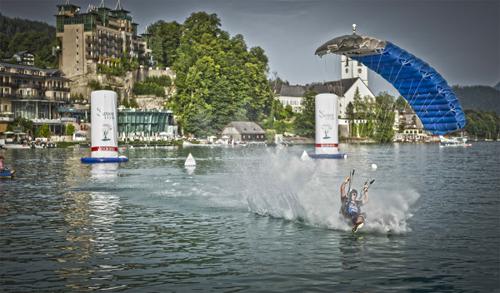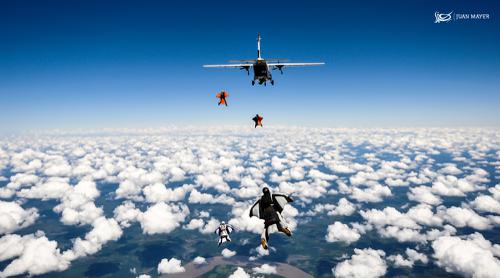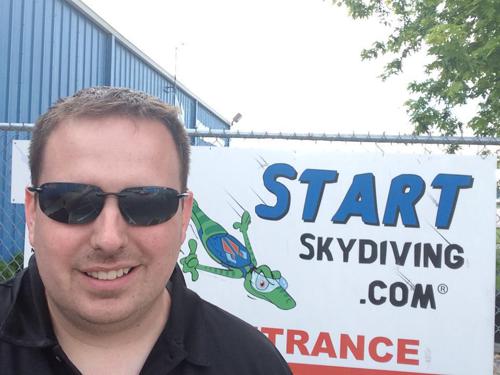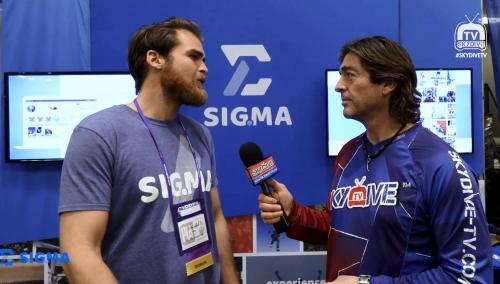I often get asked by Whuffos "Why do you jump out of planes?" At first it's always fun to say "Because the door was open" and after a few laughs I try to explain. I try to explain the 60 seconds of absolute peace. That 1 minute that nothing else matters and you're 100% focused on the moment and what you're doing. To a non jumper that explanation isn't ever really good enough I feel, and often refer to the cliche quote of "To those that jump, no explanation is necessary, and to those that don't, no explanation is possible" Because it's the closest thing to the truth.
I feel lucky to be apart of a community of amazing people! People that put aside status, careers, race, politics and are so excited to share the amazing sport of skydiving with new jumpers like myself. I didn’t know that about skydivers when I did my first tandem jump, nor did I know that I would end up traveling all over the US, meeting people from all walks of life, people I would end up calling friends and my sky family. However, one thing I do now know, is how thankful I am to have started this journey.
Everything started for me on October 14th 2013 and the set of upcoming random circumstances would lead me to so many different Dropzones around the US, which resulted in me being asked to write this story.
I was working in an industry where it was common to work really hard for 4-5 months and then take a couple months off. Right after my work season ended I decided I was going to skydive. A decision I arrived at due to various circumstances I found myself in. I was previously in the army and broke my foot the week before airborne school and always regretted not being able to jump and be apart of an airborne unit in the army. A few years after that I was working on my pilots license at a very small airport in Goshen Indiana that had a small skydiving operation on the other side of the field. Other than hearing "Jumpers Away" and making sure I didn't hit any of them while practicing take off and landings I never made it over there, even though I told myself repeatedly that I would try. Then a couple years later I met a guy by the name of Tim Kelly, randomly on a cruise ship and he had just started his skydiving training a few months before and was so excited to share with me his excitement and how awesome the sport of skydiving was! These events always left me wondering if I would take the time away from flying and scuba diving to start a new hobby.
Getting Licensed
So there I was in La Porte, IN several years later and woke up one morning and decided today is the day! I'm gonna jump out of a plane! I called all the Chicago DZ's and none of them could take me because I weighed 260 lbs. so I called around the Indianapolis area and it was the same result. A friend told me "I think they jump over in Plymouth call them" At this point I was pretty discouraged, but I had already made up my mind that somehow I was going to do a skydive! I couldn't believe that all the big operations couldn't accommodate me, but somehow the little DZ 25 min down the road might be able to. I called them up with my situation, desperate to jump, and the DZO said "Come on in. We will take a look at you and depending on your height and build we can take you if it's safe to do so".
Dropzone #1!
I hopped in the car alone and drove straight to the DZ! After arriving a gentleman named Steve Verner came over and after weighing me and sizing me up decided that it was no problem. The main parachute was rated for our combined weight and he was more than confident (with over 10,000 jumps) to safely take me on a tandem skydive. I was beyond stoked! And started filling out paperwork, watching the mandatory videos and soaking up every bit of instruction Steve was giving me.
The plane ride up consisted of Troy the DZO and Pilot on that day, Steve my Tandem Instructor and his wife Jenny the videographer. It was a 20 minute ride of smiling, while also refreshing everything I had learned on the ground. I was very impressed at all the attention that was put into safety! 10,000 feet, door opens, head back followed by 40 seconds of amazement! As soon as we landed I said I have to learn how to this! I don't care what it takes, let's get started!
That day I filled out a USPA membership application and scheduled ground school, along with my 2nd mandatory tandem, which I scheduled for the next day at the same DZ (Plymouth Sky Sports). After completing my ground school and 2nd tandem the next day I bought my first Cookie G3 Helmet. I was also measured and even ordered my first jumpsuit. I was already committing to the sport after only 2 jumps! The Dropzone would be closing for the winter 2 weeks later and the upcoming weather wasn't looking great either. I would have to wait until the next season or travel somewhere warmer to continue training, which is exactly what I did!
Dropzone #2
I called several Dropzones in Florida because I was told that with my weight and being a student, I would need a 300 sq ft Canopy to start my training (300lb Exit weight). After about my 5th call the Florida Skydiving Center in Lake Wales Florida, they told me to come on down! They had a rig that would fit me and instructors to provide the training. 1 week later I rented a small 1 bedroom house in Lake Wales and walked into the DZ to fill out paperwork. After spending a few days on a weather hold I decided to drive up to Deland and order my first container from Mirage. Apparently most people don't order their first rig until they know they are going to make it through the training, but I was committed and in my mind there was no turning back! The manager measured me and helped me design my custom green and black colors and then the wait would begin!
2 days later after a very successful AFF Level 1 skydive and a very bad no flare/no wind landing that left me wondering if I could even stand up or wave my arm to ensure my instructor I was ok (as he pleaded with me over the radio). As I heard the words "Holy Shit Bro, are you alive?" coming from a golf cart that was approaching me, I learned there was a lot more to skydiving than simply jumping out of a plane. Yes, I was alive. It was while being driven back to the hangar on the golf cart that I learned the importance of a flare. 6 hours later while in the emergency room at the VA hospital in Orlando I would also learn that a mans ACL doesn't agree with 300lbs falling from the sky without a proper flare. A lesson I wouldn't forget.
Dropzone #3
4 months later I was fully healed up and working in San Antonio Texas. This is where I would resume my training at Skydive San Marcos. My new rig was completed and I showed up at the DZ looking like a seasoned pro in my bright colored jumpsuit, helmet and new rig (but still had no idea what I was really doing). They would confuse me for a licensed fun jumper who was waiting to fill out a waiver when I was really there to start with my 4th overall jump and only my 2nd solo! After telling them an interesting story and that I was actually brand new they paired me up with 3 of the most amazing instructors I have met to date. Hank, Kevin & Pun. These were the guys that would train me now that I was healed, give me my confidence back and nurse me through 3 months of weather holds and countless times riding the plane down with other students, due to the winds kicked up too high. I stayed at San Marcos through jump 15, when a new Dropzone opened not far down the road. I ended up taking a trip there with some of my new skydiving buddies to check it out.
Dropzone #4
I decided to continue my training at Skydive Lonestar because at this point I was on coach jumps and they would allow me to use the new rig I had sitting in my car. Something the other DZ wouldn't allow me to do per their rules. This would save me gear rental fees and allow me to start getting comfortable in my own rig. The Dropzone had only been open a week and I would be their first AFF student. The staff and DZO was amazing, salt of the earth people. For days and days they would send the Otter up with only 6 or so people just so new guys could jump and I could keep training. I would always be grateful for this and wouldn't realize until later how rare it was. I would complete another 5 jumps there before moving to Houston.
Dropzone #5
I moved to Houston and Skydive Spaceland would become my new home for a while and 5 jumps later I earned my A license! It felt great to finally be a real skydiver because it had been 9 months, 5 Dropzones, several instructors and 1 injury later that I was finally able to achieve this goal. I would then learn the meaning of "BEER!" As I got my A license and stamp at Skydive Spaceland. I would learn that tradition again a few weeks later when I would biff my landing and my cutaway handle would be pulled between myself and the ground while sliding 10 feet across wet grass. (I guess that doesn't happen a lot and I have yet to see it happen again) It was apparent when the skydiver picking up his canopy 30 feet from me yelled "How the fuck did that happen! I have never seen a reserve pilot chute pop out while someone was sliding across the ground before! I bet you owe beer for that one!” Needless to say the gas station down the street would get to know me well in those first weeks.
Dropzones 6-77
Over the next year while traveling all around the country for work and taking some trips, going hours and even hundreds of miles out of the way just to jump at a new Dropzone I would figure out why I was traveling to all these DZs. I loved to jump, as anyone that completes training does I'm sure, but I found that in all my life that skydivers was the most interesting and awesome people that I have ever met. They are the only group of people (besides poker players) that you could sit amongst people without worrying about class, race, work status and discuss something you truly loved and share stories and drink beer and it would never get old. A member of the PD factory team would jump with you just to help you learn, guys and girls with thousands of jumps would share there knowledge and not make you feel inferior; But instead would share their experiences to help better everyone around them. I figured as long as I was traveling anyway I would make it a point to go to as many Dropzones and boogies and I could and seek out these amazing people to hear there stories and learn from them.
Heading For 100
It was probably about Dropzone 20 or so that I was jumping with new friends and the fact came up on how many DZs I have been to. It wasn’t strange to me to travel all over the country for work or to find new dropzones because i desperately wanted to keep jumping! However to my new friends that always jumped at the same DZ since they got licensed they found it very interesting because in a lot of cases 1 plane is all they knew. I met 100’s of people that had only jumped from a 4 person Cessna and nothing bigger. I decided then that since I was able to travel, that I was going to make it a goal to visit 100 Dropzones and try to jump at as many as I could, and from as many different planes, helicopters and balloons that I could. I knew weather would play a part and some places would only take tandems, but I was gonna do my best and just have fun with it. I started taking the "Selfies" next to the DZ sign early on to document my journey. Several years earlier I drove to all 48 continental states and did the same thing. A lot of people watched my journey on Facebook and thought it was fun, so I thought it would be a good idea for skydiving as long as I was out here doing it anyway.
More of Justin's images can be seen on his Dropzone.com profile
Common Questions
Now I could write pages and pages about my experiences, stories, boogies, jumps etc etc. But as I travel and people find out that I have jumped so many places and will continue to I get a lot of the same questions which I'm always happy to answer and still developing new answers as I jump. So I wanted to share a few of those Q&A;'s at the request of Dropzone.com and because I know I had a lot of the same questions about different places.
1. What's the nicest Dropzone you have been to?
That's a hard one to answer because there are a lot of nice DZ's. However my personal choice is CSC (Chicagoland Skydiving Center) Their facilities are amazing, all there rental equipment is top notch. The staff there go above and beyond to welcome new people to the sport and they have the nicest gear shop and restaurant in the country in my opinion. It was pretty much built for skydiving. The DZO is one of the friendliest guys you would wanna know. I don't just mean a friendly skydiver but Doug is just a pleasant friendly person in general and his attention to detail in running his operation is second to none. All of these things make it the nicest facility that I have had the privilege of jumping at.
2. What's your favorite Dropzone?
Always a difficult one to answer because it's really a 6 way tie for different reasons and the people that jump and work at these Dropzones make them a great time not only to jump at but to also hang around and have fun. They also all have a very high level of respect for safety and people willing to help you learn from your mistakes when you mess up. Those would be Skydive Windy City in Michigan City, IN. Skydive Spaceland In Texas, Chicago Land Skydiving, Skydive Chicago, Skydive Lonestar and Skydive San Marcos. I have jumped at these places more than any other and I have good friends at each of these DZ's which makes them really fun to jump at when I can.
3. What's the best view?
For me that's a tie between Skydive Utah & Skydive Windy City. Utah has these amazing mountains and the view of the Great Salt Lake. Growing up and living most my life in the Midwest I don't get to see mountains a lot and certainly not jump near them so Utah is amazing. I also love Skydive Windy City. I consider this my home Dropzone (formerly Plymouth Sky Sports) and between all the trees that surround the DZ and the view of Lake Michigan and the Chicago City Skyline on clear days it makes it a beautiful jump!
4. What's the best gear store?
Well in my mind there is no contest and that's Rock Sky Market. They are located at ChicagoLand Skydiving Center and literally have everything a skydiver could want in stock and probably with several different colors to chose from. I have purchased almost all my gear from Steve and Jenny since day one when they were selling t-shirts and pull up cords out of the corner of a hanger in Plymouth and they are the best people to work with. Not only are the knowledgeable on so much with years in the sport and well over 10,000 skydives between them but they have first hand knowledge on most of the products because they jump almost daily and use them. Between everything being right there to buy that day, there knowledge and the excellent customer service it's no contest in my mind.
5. How many DZ's have you jumped at in 1 day?
The most different Dropzones I have jumped at in 1 day is 3 and all 3 was in different states. I started off at Skydive Midwest in Wisconsin for a fun jump and then went down to Chicagoland Skydiving Center in Illinois to buy a helmet case and jumped there then on my way home I jumped at Plymouth Sky Sports in Indiana. That was an exhausting day.
6. What's your favorite boogie?
This is always a tough question but the 2 that come to mind are Summerfest and Couch Freaks. I don't know if they will hold the Couch Freaks boogie in Fort Dodge again and I might have attended the last year for it but I had a blast! Just read the back of the boogie tickets and you know you're in for one hell of a ride! I really hope they have that boogie again because the stories from the old timers there about the start of big event skydiving are second to none. As a new jumper at the time I attended I really got an education! Summerfest is also amazing with the amount of planes that come in you can really jump as much as you want. From the fireworks and glowing wing suit flights to the dinner time meals and dancing into the night. Summerfest at Skydive Chicago is really a top notch boogie!
To finish things up I’m really thankful for all the friends I have made along my journey and hopefully will continue to make. All of these opinions are of course my own, and being so new in the sport I’m sure they will continue to change as I learn and grow. I hope to hit 100 DZ’s and a few more boogies before summer is over. I hope in writing this article that the 1,000’s of jumpers who are in there comfort zone of 1 DZ will get out and experience some new DZ’s and make some new sky family. I haven’t had a bad time yet and all dropzones are welcoming to new jumpers I have found and are excited to share there stories and there sky with you! -EFS-
Justin Baker B-40015
-Blue Skies-







